#Solvent-based Systems
Explore tagged Tumblr posts
Note
Hi! I was wondering if you had any headcanons for the bots' fears/phobias? Specifically TFP
The only one I have is that Bumblebee is, ironically, afraid of bees for no reason other than I thought it would be funny. I'd like to hear your takes!
Hmm I think their fears would go something like this:
Arcee: Terrified of blood.
She's seen too much energon over the course of her long life. Watching so many good mecha die and losing both her partners has left her with a strange apathy to energon. She's grown used to it. But blood? Human blood is vibrant and so different and yet so similar. When she sees blood, it ignites old horrors and memories she's long tried to suppress. Her servos shake when one of the children ends up getting a cut large enough for her to notice. It's all too similar for her to handle.
Bulkhead: Afraid of Deep Water
Bulkhead is a big mech, one lacking in serious dexterity. He's a combat and manual labor unit and he knows it. When he was young, he fell into a solvent pool, and while unharmed, he was so heavy that he couldn't get out on his own. He was trapped there for almost a whole cycle, and now that he knows what lurks in Earth's waters, he's terrified of falling in and possibly being crushed to death by either the pressure or something that lurks in the deep. He hasn't fallen in any deep water yet, but he's terrified that it may happen and much prefers the desert.
Bumblebee: Scared of Being Alone
The fear of being alone stemmed all the way back from Bumblebee's sparklinghood. Growing up in a time of war meant that he was often left to his own devices cooped up in a base or safehouse while the grown mechs went off to war. He came to despise being left alone, and so joined the war effort both to help and to be with them. The fear of being alone only grew after he lost his voice to Megatron. When he's alone, he sometimes hears the Warlord taunting him. This can lead him to spiral badly, and so he relies heavily on others for support. This is part of the reason he bonded so well with the children.
Ratchet: Paranoid of Biological Agents
Being a Doctor, Ratchet has seen many things. Not a lot bothers him anymore, save for scraplets. But in his mind, that's not even a fear. It's common sense. But with that said, the Cybonic plague awoke in Ratchet a fear he'd never realized lurked within him. After that great plague, he now fears biological agents above all else. Not necessarily germs, but anything that could become a weapon of war. Contaminated items especially. In that regard, he is an increadible germaphobe when it comes to his supplies and will grow frantic if anything is brought into his medical bay that reeks of disease.
Ultra Magnus: Fear of the Dark
Being inside the Magnus armor means that Ultra Magnus, or perhaps Minimus, is entirely reliant on the armor's optical systems to see. The fear of the dark developed the first time he lost his sight and was completely incapable of maneuvering the armor, effectively leaving him open to any and all attacks since he couldn't use his personal field or even his senses to navigate. He has told no one about his fear, but when the lights go out, he often panics and instinctually enters a state of fight or flight out of a pure primal fear that something may harm him even within his armor. The team doesn't understand. Only Optimus knows why Ultra Magnus goes to recharge with a nightlight.
Smokescreen: Frightened by Fires
Smokescreen's fear stems from his time in the Archive. It is a new fear, one he has not fully realized. But seeing Iacon burning and the Archive coming down around him, destroying the home he'd known for so long... it changed him. At the time he was too busy being enthralled in the thrill of potential battle to care. But now, whenever he sees fire in close proximity, he automatically flies into a combat position, often lashing out at the first thing that moves simply because he associates fire with foes. Anything greater than a candle unsettles him.
Wheeljack: Unsettled by Connections
He doesn't talk about it. Ever. However, from what Bulkhead knows, Wheeljack got very attached to his ragtag family back when he was young and promptly lost them all one at a time. He tried to get attached to fellow workers before the war, but every connection fell through. Now he doesn't bother and actively flees anything that could feel like it weighs him down. He's scared of caring enough to actually cry when someone dies. Bulkhead is a rare exception to his rule of no connection, and it is simply because Bulkhead has lasted this long and all but demanded friendship.
Optimus: Petrified of Being Lost
The fear began when he was still Orion Pax. At the time, he got lost almost every time he travelled, and often, he ended up in frightening back alleys and dangerous situations. The fear evolved after he became Prime and now Optimus does not fear being lost in his journeys. Rather, he fears becoming lost within the grasp of the Matrix and the madness of war. It is such a real fear that often, Optimus will throw himself into days long studies after patrols, reviewing everything he knows about Cybertron and the corruption of the Council just so he can reaffirm who he is.
Just so he won't lose himself to the tempting thought of letting go of his morality.
#transformers#maccadam#transformers prime#team prime#ratchet#optimus prime#bumblebee#bulkhead#arcee#ultra magnus#smokescreen#wheeljack#transformers headcanon
277 notes
·
View notes
Text
I should archive my own lore notes as well, since I have the power of tumblr's tag system at my fingertips (makes posts easier to find and archive).
important world building concepts to understand wuthering waves lore:
frequencies: everything in wuwa is made of sound waves, and all world building stems from this concept. weapons are sound waves, people are sound waves, even concepts like fear and war are convertible to sound waves. everything is sound waves, also called frequencies. all frequencies can be transformed or distorted. frequencies also decay over time (ending in silence) and are usually not stable for long. this is why waveplates deplete over time, and why we use crystal solvents to stabilize.



resonators: some humans can directly manipulate vibrating frequencies (create "reverberations"), which gives them special powers that alter reality. for example: havoc rover can transform literal sound into feather blades, or gather them into an attack.


the lament: there is an ongoing calamity known as "the lament" (literally: music about grief) which causes destructive reverberations and other phenomena. the lament is what changed solaris-3 and reduced everything to sound-based physics, as well as brought waveworn phenomena like the etheric sea and tacet discord outbreaks.
remnant energy: holds "memories" but it's probably more likely that they are "stable" frequencies that haven't decayed or lost information or been distorted. aalto in act v: "various events across space and time from every dimension are recorded in the form of remnant energy." retroact rain is condensed remnant energy from the etheric sea. with these in mind, we can now think of reverberations as frequencies that have started the process of decaying, or frequencies that are no longer stable.
frequencies are data: frequencies can linger and be stored or act as data. frequencies are information. when tacet discords are defeated, their lingering frequencies create "echoes" of themselves. everyone except rover will store this as data in the gourd, and are able to use echoes in battle by simulating that data. this concept also allows us to simulate environments and events from memories. interaction with retroact rain and sonoro spheres can simulate the past because they contain the data and we "resonate" with them. when retroact rain happens over a large area, illusions pulled from the memories of multiple people can manifest at once. aalto explains that this is similar to how resonators "resonate" with the world as well. another example is the tower of adversity, which is a man-made sonoro sphere meant for simulating battles for the purposes of training.
frequencies can combine/converge: for example, rover can absorb echoes (others just store them in the gourd). tacet discords feed on other frequencies to keep themselves stable — hence why they attack us or even each other. they can also learn to mimic the frequencies they absorb often. ovathrax absorbs weapon frequencies from the norfall barren. from here, we can see why threnodians are more powerful than normal tacet discords. "if civilizations represent mankind's collective will, the threnodians embody our fears and struggles." threnodians can feed on the collapsed will of humanity (remember, everything is made of frequencies, and I really mean everything), and crownless and dreamless (ovathrax) fed on frequencies of "war" which is always abundant especially since the lament started

tacet fields: where tacet discords originate. longer dormant periods mean that the tacet discords are weaker. tacet fields connect to an "unknown space" through a white resonance cord, and feature a tacet mark and the etheric sea. now, who else do we know came from an unknown space with a tacet mark and "fell" (was pushed by a goddess) from the etheric sea?

convenes: I also think it's interesting that the way convenes works is that we created a white resonance cord and pull someone from the etheric sea. if you fight the crownless, you have interact with the resonance cord as well. really makes you wonder if threnodians and tacet discords are really any different from resonators. they both resonate with other frequencies. but what makes a resonator's own frequency more stable than a tacet discord, who has to keep feeding on others to be stable?


#mine musings#liveblogging wuwa#wuthering waves#wuthering waves meta#i just realized the convenes one today#knowing that kuro are nier automata fans... lol. this is just machine vs androids and all over again#i need to catch up to pgr but they played with this concept too with ascendants machines constructs etc
24 notes
·
View notes
Text
Here's my hot take.
The human body is an extremely complex, finely-detailed machine that runs 24 hours a day, and which exists in an adversarial environment (against microbes, mostly). That it will break down eventually is inevitable.
Often, people don't think about their own mortality.
Privatized medicine puts a price on people's mortality. "Would you," it asks, "pay $50,000 to live another 10 years?" As it happens, if it's another 10 healthy years, that's a fantastic deal. However, it's forcing people to confront their own mortality at the same time that it's confronting them with a $50,000 bill and shoving the pen into their hands.
And of course, each year, the human body degrades, so each year, the next deal offered by privatized medicine is worse, until you reach some vague point where further survival is no longer worth the money, or no longer worth the effort it would take to get the money.
If you just want to give medical care to the poor, you could use vouchers. In addition to conventional moral justifications about compassion, fairness, "it could happen to any of us," etc, healing someone can also improve their productivity, and that includes getting them out of an illness-induced low-productivity doom loop where they can't pay for care because they won't be productive again until after receiving the care.
Under socialized medicine, the patient receives a tax bill every year. When they hit the injury, the government, the biggest authority in the land, either tells them yes or no, through their class of certified medical experts, who are also brimming with socially-maintained authority.
So the patient gets injured, and does not get confronted with a direct bill, and as they are facing their mortality, the big authority of the land tells them, "I'm so sorry, there is nothing we can do. 😔"
The price is still there. The procedure still costs perhaps $45,000. There never stopped being a price. We never stopped putting a monetary value on human life, as someone still had to make the call based on that price. It's just hidden.
This upsets a different set of people, who go, "Excuse me, you bureaucratic crank. I have $50,000. I can just buy this procedure. Who are you to tell me that I can't?"
Personally, my experience with the US Affordable Care Act (i.e. "Obamacare") has been that the healthcare.gov customer service has been effective and responsive, and I like not having to worry so much that I'll get dropped from coverage. Every health insurance policy not on the exchange appears to be fake, and moving away from Obamacare suggests turning more claims into simultaneously being sick while fighting a legal battle. However, I don't actually use much healthcare.
In the coming years, we may need to impose a cap on lifetime coverage through Obamacare in order for the system to remain solvent, as more diseases move from "untreatable" to "treatable, but very expensive." I selfishly hope that it will continue to pay spectacular amounts for gene therapies over the coming 5-10 years to build up the industrial base for the industry so that long-term costs come down, and we can say goodbye to, "Oops, my baby got a single mutation that gave him Logan's Run Disease, and is now going to die."
9 notes
·
View notes
Text
Researchers uncover a rapid, efficient and environmentally friendly method for selective lithium recovery using microwave radiation and a readily biodegradable solvent. A microwave-based process boasts 50% recovery rate in 30 seconds. The "white gold" of clean energy, lithium is a key ingredient in batteries large and small, from those powering phones and laptops to grid-scale energy storage systems. Though relatively abundant, the silvery-white metal could soon be in short supply due to a complex sourcing landscape impacted by the electric vehicle (EV) boom, net-zero goals and geopolitical factors. Valued at over $65 billion in 2023, the lithium-ion battery (LIB) global market is expected to grow by over 23% in the next eight years, likely heightening existing challenges in lithium supply.
Read more.
15 notes
·
View notes
Text
Is Your Water Bottle Really Made From Recycled Plastic? (New York Times)
Excerpt from this New York Times story:
The plastic CamelBak bottles displayed in a Target in East Hanover, N.J., offer a promise to ecologically conscious buyers. On the front of each is a bright blue sticker with the words “Tritan Renew made with 50% recycled material.”
In reality, however, the amount of recycled plastic that went into making the bottles may be nowhere near 50 percent.
Eastman Chemical, a company with $9.2 billion in annual revenues based in Kingsport, Tenn., introduced the durable plastic called Tritan Renew four years ago, telling manufacturers that it was made with “up to 50 percent recycled content from waste plastic.” It quickly caught on with companies trying to reach their sustainability goals or eager to appeal to consumers who want to keep plastics out of landfills and oceans.
Dozens of brands now use the material. CamelBak and Nalgene use it in sports water bottles. Ferragamo offers Tritan Renew sunglasses. Stanley Black & Decker even made a new power tool line called Reviva from the plastic. But there is no guarantee that any particular bottle, pair of sunglasses or power tool actually contains recycled plastic.
“It could be a very low percentage that is physically in there; it could be a high percentage,” said C. Jason Pierce, a senior technical leader for the Circular Economy and Life Cycle Assessment at Eastman Chemical, when asked this spring about the amount of recycled plastic in Tritan Renew that is used to make water bottles sold by CamelBak and others. “You can’t know how much.”
So how does Eastman make its claim that Tritan Renew contains up to 50 percent recycled material? It uses a green certification system called “mass balance.”
That methodology allows companies like Eastman to build up credits for recycling plastic and then apply them to the manufacture of any number of products, regardless of how much recycled material they contain. (More on this later.)
Critics argue that mass balance accounting opens the door to corporate greenwashing and creates a system where consumers don’t know whether or how much recycled material was used in products that claim to be sustainable or “green.”
“If you divorce the recycled content from the physical product, and just start using these accounting schemes, you destroy consumer confidence in recycling,” said Lee Bell, a policy adviser to the International Pollutants Elimination Network, a global network of advocacy groups that works on pollution issues. “It effectively destroys truth in labeling.”
That view, the company argues, takes too narrow a perspective. Consumers can be assured “that they are directly supporting recycling that really did happen,” Mr. Pierce said. “Materials that would have otherwise gone to the landfill or incinerator are being recycled. It’s just a little bit of a different way of thinking about recycling. More of a bigger picture or systems view of it. ”
To grasp what mass balance accounting entails, you first have to know a bit about the two methods of plastic recycling.
The first, which has been around for decades, involves sorting, washing, shredding and melting down plastic waste and reshaping it into pellets. Much of the recycled plastic produced by this method, called mechanical recycling, is of lesser quality than the original. And only certain types of plastics can be recycled mechanically.
The second, newer method, chemical recycling, is an energy-intensive process that typically uses high temperatures, pressurization and chemical solvents or other chemical processes not to simply melt plastic but to break it down into its chemical building blocks. The recycled chemicals are then mixed with all sorts of other materials, including fossil-fuel-derived virgin plastic, to make new products.
This year, Eastman began operating one of the largest chemical plastic recycling plants in the world. Near the company’s headquarters in Tennessee, the plant uses methanol, heat and pressure to transform plastic waste. It takes plastics not accepted in most curbside recycling programs, like clamshell containers, colored plastics used in food and beverage packaging, and plastic fibers used in carpets and textiles.
Eastman wants to be able to market as recycled the products made with this material. But while it’s theoretically possible to physically track plastic pellets from recycled water bottles to a new life as plastic lawn furniture, it’s virtually impossible to trace basic chemicals dissolved from plastic waste and mixed with other materials to any particular batch of plastic products.
4 notes
·
View notes
Quote
Health insurance is not really like those other types of insurance. Everyone, eventually, will need healthcare; some need more, some need less, but everybody needs some. Even the healthiest individuals should be seeing a doctor and a dentist at least once a year for routine checkups and maintenance. For some, health insurance is procured with the explicit knowledge of both insured and insurer that the insured will regularly be drawing on it. Reliably, we’ll need more healthcare services we age than we do when we’re young and fit. And so the risk burden is heavily tilted towards our senior population - who are also the people that are past their prime earning years and face the largest impediments to making enough money to pay for healthcare, typically precisely because of various medical issues. This presents a problem that’s part of a larger problem. The lower-order problem is that the young and healthy have little incentive to purchase health insurance based on their risk profile, and even those who choose to purchase some form of health insurance would likely prefer to pay only for bare-bones catastrophic coverage. That means that the lowest-risk potential policyholders would essentially keep their money out of the system, while the highest-risk would have no choice but to remain in it. This results in an insurance pool that would require sky-high premiums to stay solvent and generate profits. Which points to the higher-order “problem”: we have, thankfully, a strong community moral instinct that people shouldn’t be denied medical care because they can’t pay, which destroys the capitalist logic that underlies most purchases.
Why Government Intervention in Healthcare is Necessary (and Inevitable)
24 notes
·
View notes
Text
Water Hash: The Pure and Potent Extraction Method
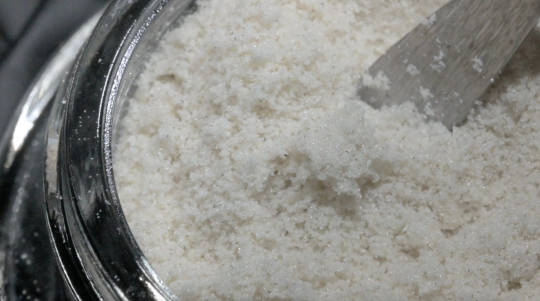
Water hash, a favourite method of making cannabis concentrates worldwide, has gained significant popularity due to its pure and potent characteristics. This article will delve into the details of water hash, its production methods, its surge in popularity, and how it competes with solvent hash.
Understanding Water Hash
Water hash, also known as bubble hash, gets its name from the efficient water-based process used to collect glands from the trim, leaf, and bud bits of the cannabis plant. It is essentially a loose, kief-type product that can be smoked directly or pressed into traditional hashish form. The result is a pure and potent product that quickly wins over many who experience it.
Production of Water Hash: Simplicity and Precision

One of the main attractions of water hash is its simple production process. It can be made in small or large quantities, depending on the user's needs. The ready-made systems available in the market have significantly simplified the process. These systems have enhanced the precision and efficiency of the water hash production process, contributing to its increasing popularity.
For those who prefer a DIY approach, it's possible to make water hash using home-gathered equipment. The key components include ice, water, cannabis material, and specially designed "bubble bags" that help filter out the trichomes from the plant matter. This simplicity makes it an accessible option for many.
The Rise of Water Hash Popularity
Over the past two decades, water hash has dominated the world of cannabis concentrates. Its popularity stems from its pure and potent nature, which offers users a high-quality experience. Additionally, the absence of harmful solvents and chemicals in the extraction process makes it a safer choice, not only for consumption but also for production, as there's no risk of explosions or exposure to hazardous materials.
Competition with Solvent Hash
However, water hash's reign is being challenged by the rise of solvent hash. Products like wax, shatter, budder, and oil have begun to replace bubble hash on many dispensary shelves in the United States over the last few years.
The competition from solvent hash has forced water hash makers to up their game. Ultra-fine water hash is now being marketed as "solventless" wax, reflecting a level of distrust about poorly made butane-tainted products. High-grade water hash is also excellent for edibles, and the best of it is indeed dabable.
The Safety of Water Hash
One of the significant advantages of water hash is its safety. The production method doesn't involve any sketchy chemicals or pose a risk of explosions. This safety factor, combined with the pure and potent nature of the product, continues to make water hash a preferred choice for many.
In conclusion, water hash offers a simple, safe, and efficient method for producing high-quality cannabis concentrates. Despite the increasing popularity of solvent-based products, water hash continues to hold its ground due to its purity, potency, and safety. Whether you're a novice or an experienced user, Water Hash provides a unique and satisfying experience.
11 notes
·
View notes
Note
🪣: the Vehicons have been working on building some actual wash racks now that we’ve cleared out the bunker*, and Toxitron has been trying to make solvent. So far, he hasn’t made anything explode.
T: I’m used to making hazardous chemicals. Soap is a whole new ordeal...
Kitty: whatever you have created smells awful.
T: I know…
🪣: …we’re getting there. And don’t worry, mum had a long talk with Monsoon and Downpour about hygiene. A long talk that involved a lot of shouting, gesticulation and smacking them with a slipper.
W: Waspinator hopes to never incur her wrath…
🪣: I had to fish a beetle out of Monsoons plating, so he’s been sufficiently discouraged from the mud. Luckily, we don’t have to worry about him getting sick thanks to the experiments Shockwave did.
Kitty: the benefits of being Plague Carriers I suppose.
You're building wash racks? Where're you based? That can be pretty awkward. Especially the voids and waste systems.
Are you offering help?
Uh... I was gonna volunteer Nightshade 'n' Thrash. Thrash was telling me about how he 'n' Nightshade built the washracks in the dugout all by themselves.
Thrash is a champion bragger. I think he might even be able to beat Starscream and Bumblebee in a bragging contest.
Oh. Does that mean he didn't actually build anything?
No. It just means he might not be as much help as you think. If Nightshade said they'd built facilities without help from Alex, Dot or Bumblebee, I'd be more inclined to believe it.
Same here.
#asks answered#transformers#hot rod#optimus prime#megatron#building washrack facilities#anonymous asks#🪣
3 notes
·
View notes
Text
SOURCE PROTOCOL

SOURCE is building limitless enterprise applications on a secure and sustainable global network. Defi white-labelled services, NFT markets, RWA tokenization, play-to-earn gaming, Internet of Things, data management and more. SOURCE is providing blockchain solutions to the real world and leveraging the power of interoperability.
SOURCE competitive advantages over other blockchain projects
For builders & developers — Source Chain’s extremely high speeds (2500–10000+ tx / per second), low cost / gas fees ($0.01 average per tx), and scalability (developers can deploy apps in multiple coding languages using CosmWasm smart contract framework), set it apart as a blockchain built to handle mass adopted applications and tools. Not to mention, it’s interoperable with the entire Cosmos ecosystem.
For users — Source Protocol’s DeFi suite is Solvent and Sustainable (Automated liquidity mechanisms create a continuously self-funded, solvent and liquid network), Reduces Complexity (we’re making Web 3.0 easy to use with tools like Source Token which automate DeFi market rewards), and we’ve implemented Enhanced Security and Governance systems (like Guardian Nodes), which help us track malicious attacks and proposals to create a safer user environment.
For Enterprises — Source Protocol is one of the first to introduce DeFi-as-a-Service (DaaS) in order for existing online banking and fintech solutions to adopt blockchain technology with ease, and source also provides Enterprise Programs which are complete with a partner network of OTC brokerages, crypto exchanges, and neobanks that create a seamless corporate DeFi experience (fiat onboarding, offboarding, and mutli-sig managed wallets)
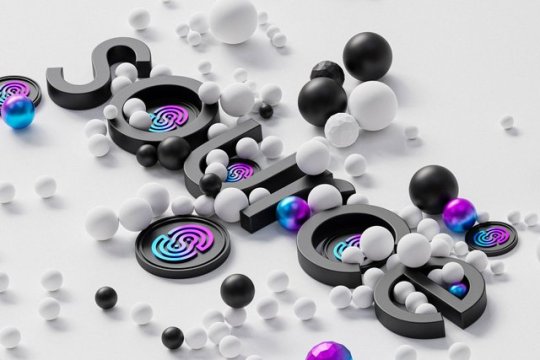
Why Source Protocol
Firstly, many protocols are reliant on centralized exchanges for liquidity, limiting their ability to scale independently. This creates a lot of the same issues traditional finance has been plagued with for decades.
Next — slow tx speeds, high costs, limited scalability, and inability to collaborate with other chains, has created severe limitations in Gen 2 blockchain infrastructure.
Lastly, there still exists a level of complexity in blockchain applications that remains a barrier to entry for the average user, and there is not enough focus on building “bridges” for the enterprise to adopt this technology easily and quickly.
In summary, consumers are eager for a blockchain ecosystem that can securely and sustainably support mass adopted applications. That’s why we’ve built Source!
Source Protocol’s ecosystem
Source Protocol’s ecosystem includes a full DeFi Suite, a members rewards program and white-label integration capabilities with existing online Web 2.0 enterprises:
Source Swap — An Interchain DEX & AMM built on Source Chain for permission-less listing of $SOURCE-based tokens, native Cosmos SDK assets, cw-20’s, and wrapped Binance Smart Chain (BEP-20) assets.
Source One Market — A peer to peer, non-custodial DeFi marketplace for borrowing, lending, staking, and more. Built on Binance Smart Chain with bridging to Source Chain & native Cosmos SDK assets.
Source Token $SRCX (BEP-20) — the first automated liquidity acquisition and DeFi market participation token built on Binance Smart Chain.
Source One Token $SRC1 (BEP-20) — a governance and incentivized earnings token that powers Source One Market.
Source USX $USX (BEP-20) — Source One Market stablecoin backed and over collateralized by a hierarchy of blue chip crypto assets and stablecoins.
Source Launch Pad — Empowering projects to seamlessly distribute tokens and raise liquidity. ERC-20 and BEP-20 capable.
Source One Card & Members Rewards Program — users can earn from a robust suite of perks and rewards. In the future, Source One Card will enable users to swipe with their crypto assets online and at retail locations in real time.
DeFi-as-a-Service (DaaS) — Seamless white-label integration of Source One Market, Source Swap, Source Launch Pad, and/or Source One Card with existing online banking and financial applications, allowing businesses to bring their customers DeFi capabilities.
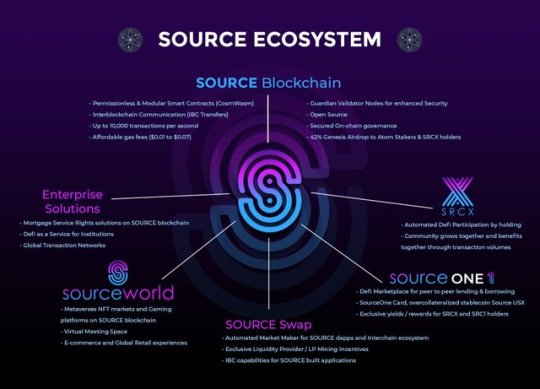
Source Protocol Key Components
Sustainable Growth model built for enterprise involvement and mass application adoption
Guardian Validator Nodes for enhanced network security
Integration with Source Protocol’s Binance Smart Chain Ecosystem and Decentralized Money Market, Source One Market
Source-Drop (Fair community airdrop and asset distribution for ATOM stakers and SRCX holders)
Interoperable smart contracts (IBC)
High speed transaction finality
Affordable gas fees (average of $0.01 per transaction)
Highly scalable infrastructure
Open-source
Permission-less Modular Wasm + (EVM)
Secured on-chain governance
Ease of use for developers
conclusion
SOURCE is a comprehensive blockchain technology suite for individuals, enterprises and developers to easily use, integrate and build web3.0 applications. It is a broad-spectrum technology ecosystem that transforms centralized web tools and financial instruments into decentralized ones. Powering the future of web3,
Next — slow tx speeds, high costs, limited scalability, and inability to collaborate with other chains, has created severe limitations in Gen 2 blockchain infrastructure.
Lastly, there still exists a level of complexity in blockchain applications that remains a barrier to entry for the average user, and there is not enough focus on building “bridges” for the enterprise to adopt this technology easily and quickly.
In summary, consumers are eager for a blockchain ecosystem that can securely and sustainably support mass adopted applications. That’s why we’ve built Source!
For More Information about Source Protocol
Website: https://www.sourceprotocol.io
Documents: https://docs.sourceprotocol.io
Twitter: https://www.twitter.com/sourceprotocol_
Instagram: https://www.instagram.com/sourceprotocol
Telegram: https://t.me/sourceprotocol
Discord: https://discord.gg/zj8xxUCeZQ
Author
Forum Username: Java22
Forum Profile Link: https://bitcointalk.org/index.php?action=profile;u=3443255
SOURCE Wallet Address: source1svnzfy5fafuskeaxmf2sgvgcn6k3sggmssl8d7
2 notes
·
View notes
Text
My Worldbuilding: Vampires (3)
Links: (1)(2)

New Anatomy
A vampiric coma can last anywhere from a four days to the longest recorded being five months. No one knows what exactly causes such strong differences in length, but it is currently belief that it correlates with the amount of changes to the infected’s anatomy.
The new vampire is now running off of their new anatomy upon waking, all of which had been rearranged during their deep sleep. Their body no longer runs off of calories, or many of the same stuff as before. A complete overhaul has happened on the body’s system.
Several of the body’s organs fail while in the coma to become reabsorbed or shrunken by the infected’s body; including much of intestines, liver, kidneys. This gives room for new nerves, and a group of new organs form. The lungs change function from breathing, to become an assistant to the diaphragm and the endocrine system, which will work together to make feeding an easy task for the vampire.
The endocrine system, lymph nodes, and cardiovascular system overtake the digestive system, as the body will be receiving liquids instead of solids for fuel/energy again. Instead consumption for nutrients will happen primarily in the blood stream, and a smaller version of the stomach. Veins, the heart, and stomach pick up the needed nutrients for vampires. Blood pressure is now naturally slower, and the skin is pale to a change blood.
Fangs
The vampire’s fangs is one of the most important features that every vampire has. Without them their lives become much more difficult, and health can deteriorate quickly. The fangs have many features aside from just puncturing the skin.
Glands of different types now exist within base of the vampire’s neck. Occasionally some infected have extra patterned throughout the body alongside the endocrine system. These are paired with several solutions that secrete from the fangs. The vampire is in charge of using these injections, but a new one won’t be used to it yet and will use each loosely until they do.
Vampires can use multiple in a bite, and choose not to use any. Types of venoms & solutions include.
Vampiric Essence (Infects bitten individual)
Instant pain killer (Numbs bitten individual so the process isn’t incredibly painful)
Soother (Makes the bitten individual relax, and causes the experience to feel pleasurable. Soothes people both physically and emotionally)
Paralytic (paralyzes the bitten individual temporarily)
Sedative (forces bitten individual into a deep sleep temporarily)
Healing Solvent (Vampire licks the solvent off of their fangs, and then over the bite. Causes the bite to heal quicker, and soothes the pain/inflamation)
#my worldbuilding#worldbuilding#vampires#vampirism#vampiric#my writing#writing#writing vampires#worldbuilding vampires
27 notes
·
View notes
Text
Jerry Can Gear Pump Based Filling Machine

Company Overview: Shiv Shakti Machtech is Manufacturer, Supplier and Exporter of Jerry Can Gear Pump Based Filling Machine. A Jerry Can Gear Pump Based Filling Machine is a state-of-the-art liquid filling system designed to handle the precise filling of jerry cans and similar containers. This type of filling machine utilizes a high-quality gear pump mechanism, ensuring accurate and efficient dispensing of liquids in industries such as chemicals, lubricants, oil, food and beverage, and more. Our Jerry Can Gear Pump Based Filling Machine is ideal for multiple applications, including Jerry Can Filling Machine, Filling machine for oil, chemical, Jar, Jerry can bulk filler, 25 liter Oil Jerry can filling machine, 5 Liter Jerry Can Filling Machine, Edible Oils Filling Machine for Jerry Can, 5kg 10kg 15kg 25kg Pail Big Gallon Filling Machine, Bucket Paint Jerry Can Gear Pump Viscous Liquid Filling Machine, Lube Oil Jerry Can Filling machine, Jerry Cans Packaging Line, Positive Displacement Pump Jerry Can Filling Machine, Serov Filling Machine for Jerry can, Specifications: The Filling Principal: Gear Pump / Flowmeter / Loadcell Filling Range: 5 liter to 50 liter - different model available The Filling Liquid: Oils, Liquids, Solvent, Paints, semi viscous liquids Filling Container: Jerry Can, Bucket, Gallon, Pail Number of Filling Head: 2 to 16 heads - different model available Construction: Stainless Steel Shiv Shakti Machtech is a Jerry Can Gear Pump Based Filling Machine and an exporter worldwide, including Algeria, Angola, Antigua, Barbuda, Argentina, Armenia, Australia, Austria, The Bahamas, Bahrain, Bangladesh, Belarus, Belgium, Belize, Benin, Bhutan, Bolivia, Botswana, Brazil, Brunei, Bulgaria, Burkina Faso, Cambodia, Cameroon, Canada, Central African Republic, Chad, Chile, Colombia, Congo, Democratic Republic of the Congo, Costa Rica, Cuba, Cyprus, Denmark, Dominica, Ecuador, Egypt, Guinea, , Fiji, Finland, France, The Gambia, Georgia, Germany, Ghana, Greece, Guyana, Hungary, Iceland, Indonesia, Iran, Iraq, Ireland, Israel, Italy, Jamaica, Japan, Jordan, Kazakhstan, Kenya, South Korea, North Korea, Kuwait, Kyrgyzstan, Laos, Latvia, Lebanon, Libya, Malawi, Malaysia, Maldives, Mali, Mauritania, Mauritius, Mexico, Moldova, Monaco, Mongolia, Morocco, Mozambique, Myanmar (Burma), Namibia, Nepal, Netherlands, New Zealand, Niger, Nigeria, Norway, Oman, Panama, Peru, Philippines, Poland, Portugal, Qatar, Romania, Russia, Rwanda, Saint Lucia, Saudi Arabia, Senegal, Serbia, Singapore, Slovakia, Somalia, South Africa, Spain, Sri Lanka, Sudan, South Sudan, Sweden, Switzerland, Syria, Taiwan, Tajikistan, Tanzania, Thailand, Togo, Tunisia, Turkey, Uganda, Ukraine, United Arab Emirates (UAE), United Kingdom, United States, Uruguay, Uzbekistan, Vanuatu, Vatican City, Venezuela, Vietnam, Yemen, Zambia, Zimbabwe. For further details or inquiries, feel free to reach out to us. View Product: Click Here Read the full article
#Ahmedabad#Algeria#Angola#Antigua#Argentina#Armenia#Australia#Austria#Bahrain#Bangladesh#Barbuda#Belarus#Belgium#Belize#Benin#Bhutan#Bolivia#Botswana#Brazil#Brunei#Bulgaria#BurkinaFaso#Cambodia#Cameroon#Canada#CentralAfricanRepublic#Chad#Chile#Colombia#Congo
1 note
·
View note
Text
Neon Genesis Evangelion 11

Most of this episode is just characters restating the problem over and over.

Basically, Tokyo-3 experiences a power outage. The NERV base is also affected, which results in Misato and Kaji getting trapped in an elevator the whole time.
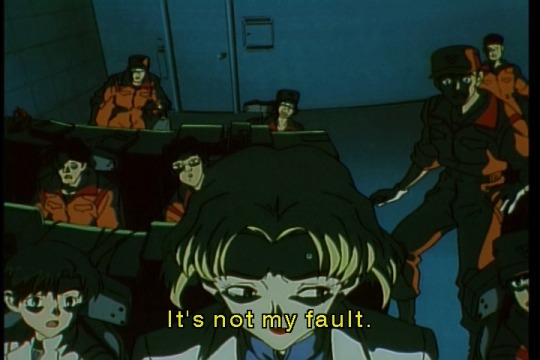
What makes this especially irritating is that the story keeps teasing interesting plot developments only to abandon them immediately. For example, the episode opens with Ritsuko and other NERV staffers discussing the three Magi supercomputers that run Tokyo-3's government. So maybe the blackout is tied in with the Magi? No, it's not. Ritsuko had planned to run tests on Eva Unit 00 today, so maybe that's what caused the blackout. No, it wasn't that.

Oooh, maybe Gendo Ikari sabotaged his own facility, as part of some weird scheme he's up to... nope, he doesn't know who did it either. He just knows it must have been a human enemy, which is ironic, since NERV is trying to save humanity from the Angels. Well, at least it'll be fun to unmask the saboteur... no, that never happens. If we ever find out who did this, it isn't in this episode.
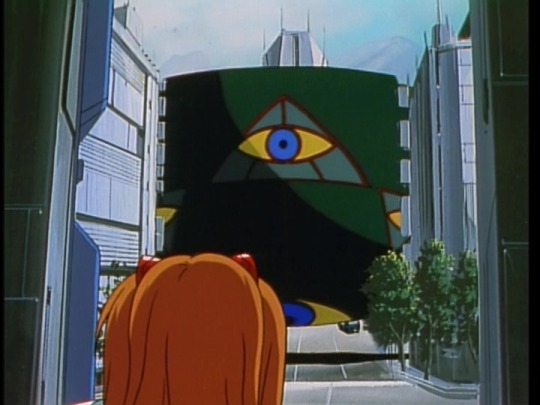
Vice Commander Clownshoes points out how it would be disastrous if an Angel attacked at a moment like this, and that's exactly what happens. So you'd think this episode would be focused on getting the power back in time to fight the thing, but not quite.
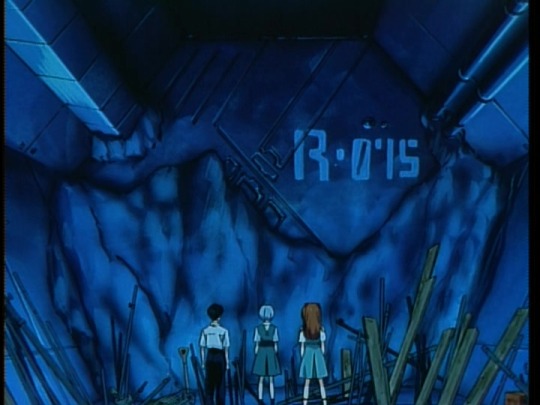
Mostly, the focus is on Shinji, Rei, and Asuka as they attempt to enter the base without any power. Rei has emergency instructions in her purse, and Asuka declares herself the leader, and they bicker the whole way in. For some reason they crawl through ductwork, and it's kind of boring because it's not like anything will attack them on their own turf. There won't be a malfunctioning security system or anything like that, because the power's down.

As the Angel threat becomes more pressing, Gendo Ikari orders the Evas to be prepared for launch, using a diesel engine that was set up in case of emergency. We see him helping the others to set up all the stuff with pulleys instead of machines. I'm not sure how any of it works, but whatever.

So when Shinji arrives, he's surprised to find the Evas ready for use. Ritsuko tells him that his dad believed that the pilots would show up when they were needed, and so they did. Nice.
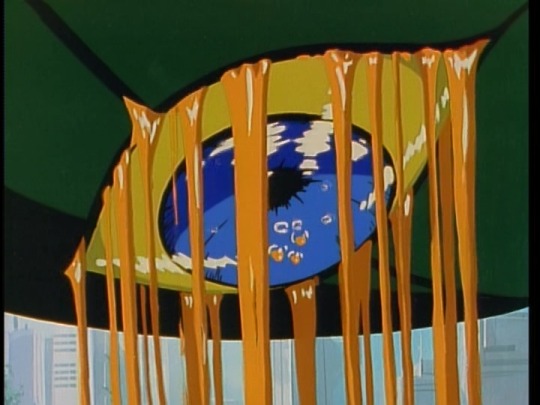
So when they're finally ready to deploy, the Evas have to ascend a vertical shaft, but the Angel is waiting above them, secreting a corrosive solvent down onto them.

They only have a few minutes of battery power to work with, so Asuka finally proves her worth and comes up with a plan. She takes her Unit 02 up into the shaft to defend the others. Rei goes down to retrieve the weapons they dropped earlier. Then she'll hand off the weapon to Shinji, who will open fire on the Angel. Asuka takes the defense job because it's more dangerous and she wants to repay Shinji for helping her out of that volcano in the last episode.

And it works! Another Angel bites the dust. I think this is the eighth one? It's enough of them that I've lost count.
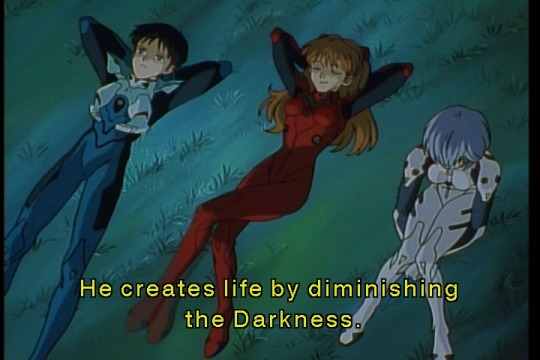
With that settled, the kids chillax outside while they wait for the grownups to restore power to the city. Rei waxes philosophical about how humans fear the darkness, so they scrape away at its edges with fire. Whatever you say, kid.
#neon genesis evangelion#2024ngeliveblog#shinji ikari#asuka langley soryu#rei ayanami#gendo ikari#clownshoes#misato katsuragi#ritsuko akagi#kaji ryoji
4 notes
·
View notes
Text
The 3 R's of Waste Management
Reduce, reuse, and recycle.
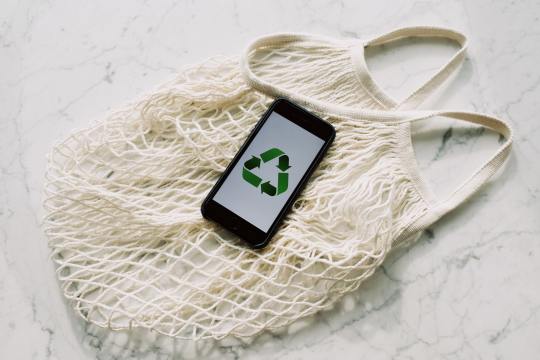
The 3 R's are the necessary foundations of conservation and waste management techniques for a more sustainable lifestyle.
Sustainability, in its environmental definition, is the ability to maintain conditions supporting biological life on Earth by preserving natural resources. The continued prevalence of diminished natural resources due to the rise in greenhouse gas emissions, such as carbon dioxide and methane, from human activity over the past decades has impacted our course of sustainability on planet Earth. However, reducing, reusing, and recycling materials will lessen energy consumption instead of mining, extracting, and producing new goods with raw materials. These forms of waste management will allow trees to be planted in areas to lessen the carbon dioxide in the atmosphere that would otherwise be used as landfills for trash.
Reduce
Overconsumption of products that yield mass amounts of trash can contribute to the problem that waste management is trying to fix. Being aware of the issue at its roots and diminishing the need to throw away items can better sustain and handle the waste output that one is producing. Reducing the amount of discarded waste can also lessen the need to reuse or recycle items constantly.
Some ways to reduce and use preventative measures are to:
use reusable forms of everyday daily items such as reusable beeswax food wraps, washable utensils, electric lighters, metal razors, and recycled grocery bags
compost compostable foods at compost centers in your state
shop at zero-waste grocery stores in your state
avoid throwaway items such as single-use cutlery and dishes
replace paper items with fabric or cloth options such as fabric napkins, dishcloths, and cotton paper towels
buy products in bulk as opposed to small, single-use containers

Reuse
Often, it can be easy to discard packaging or items that no longer work or have a use for them. Instead, one should put creativity into practice when thinking of ways to reuse an object instead of throwing it out entirely and increasing waste output.
Some ways to reuse common thrown-away items are to:
turn used milk, coffee, juice, and water cartons into birdhouses
grow seedlings in empty egg cartons
use empty plastic milk jugs for your garden in creative ways
clean out glass jars or containers and repurpose them as a storage component
sell or donate old clothes, furniture, appliances, etc., to those who can use it
reuse grocery bags to cover small trashcans or on your next trip to the store
utilize newspaper as a way to cushion fragile items for storage
use leftover wood as fuel for bonfires
donate old notebooks and books for children who are in need of them

Recycle ♻️
At times, it can be easier to throw away used goods rather than recycle them and allow them to redirect potential waste from landfills, conserve energy, and reduce the need to extract new materials for new products. According to the EPA, "recycling one ton of paper would save enough energy to power the average American home for six months, save 7,000 gallons of water, save 3.3 cubic yards of landfill space, and reduce greenhouse gas emissions by one metric ton of carbon equivalent (MTCE)."
Some ways to get started with recycling items can be to:
buy items that are made with recycled materials so that once it is used up, you can recycle them and restart the process
educate yourself on the plastic recycling symbols and learn what they mean and if they can be recycled
be aware of the fact that not all plastics can be recycled at certain facilities
clean out hazardous/unrecyclable contents before recycling items
choose to buy things that are made with water-soluble solutions instead of chemical-based solvents
look out for materials that local recycling facilities are accepting, and start collecting recyclable items
use public blue bins that indicate if they accept paper, glass, or plastic for an easy-access recycling system

Efforts to start being sustainable might seem to make a slight difference amongst the tons of trash thrown away daily, but having one person reuse, reduce, and recycle, can make a big difference in a healthier Earth.
Sources
“3rs - Reduce, Reuse & Recycle.” SustainableSA.Com, 2 Aug. 2016, www.sustainablesanantonio.com/practices-technology/reduce-reuse-recycle/.
“Basic Information Details | Paper Recycling.” United States Environmental Protection Agency, 21 Feb. 2016, archive.epa.gov/wastes/conserve/materials/paper/web/html/index-2.html.
“Climate Change Indicators.” United States Environmental Protection Agency, 1 Aug. 2022, www.epa.gov/climate-indicators/greenhouse-gases.
“Climate Change, Recycling, and Waste Prevention.” Climate Change, Recycling and Waste Prevention from King County’s Solid Waste Division - King County, kingcounty.gov/depts/dnrp/solid-waste/programs/climate/climate-change-recycling.aspx. Accessed 1 July 2023.
Fahad. “3 R’s of Environment - Reduce, Reuse, Recycle.” Earth Reminder, 4 Jan. 2020, www.earthreminder.com/3rs-of-environment-reduce-reuse-recycle/.
#environment#recycle#reduce#earth#epa#environmentalism#climate change#climate justice#recycle reuse renew rethink#reusedmaterials#reduce reuse recycle#ecofriendly#sustainability#sustainable#recycled#environmetalists
8 notes
·
View notes
Text
The Future of Auto Engine Cleaning: Innovations in Dry Ice Blasting
In the ever-evolving world of automotive technology, innovation is the driving force behind improvements in engine performance, environmental sustainability, and overall driving experience. As engines become more advanced, so do the methods used to clean and maintain them. One of the most promising innovations on the horizon is "dry ice blasting in automobile" engine cleaning, a revolutionary approach that is set to reshape the future of auto maintenance. In this blog post, we will explore the latest developments and the potential of Dry Ice Blasting in the Automotive Industry.
Dry Ice Blasting in Car Engine
The Importance of Engine Cleaning
A clean engine is not just a matter of aesthetics; it's crucial for optimal performance and efficiency. Over time, engines accumulate dirt, grime, carbon deposits, and other contaminants that can negatively impact their function. Regular engine cleaning is essential to maintain fuel efficiency, reduce emissions, prevent damage, and extend the life of the engine. In this context, the emerging technology of dry ice blasting promises to be a game-changer.
Traditional Engine Cleaning Methods
Before diving into the innovative aspects of dry ice blasting, let's take a quick look at the traditional methods for engine cleaning:
Chemical Cleaning: Chemical solvents and degreasers are commonly used to dissolve and remove dirt and grime. However, these chemicals can be harmful to the environment and pose health risks to those handling them.
Abrasive Cleaning: Sandblasting or other abrasive methods involve blasting particles at the engine surface to remove contaminants. These methods can be effective but also risk damaging engine components.
Water-Based Cleaning: High-pressure water jet cleaning is used to remove dirt, but it can result in water waste and may not be suitable for certain engine parts.
The Rise of Dry Ice Blasting
Dry ice blasting is a cutting-edge cleaning method that leverages solid carbon dioxide (CO2) pellets. When these pellets are propelled at high speeds and impact the surface to be cleaned, they undergo a process known as sublimation, transitioning directly from a solid to a gas. This sublimation process creates mini-explosions on the surface, effectively dislodging and removing contaminants.
What Sets Dry Ice Blasting Apart?
The adoption of dry ice blasting in the automotive industry is driven by several key advantages:
Non-Arasive: Unlike traditional abrasive methods, dry ice blasting is non-abrasive and gentle on engine components. This non-destructive approach ensures that the engine parts remain undamaged.
Eco-Friendly: Dry ice is a byproduct of industrial processes, making it an environmentally friendly choice. It produces no secondary waste, chemical residue, or harm to the environment.
Efficient: Dry ice blasting is a highly efficient cleaning method, reducing labor hours and downtime for the vehicle, which can lead to cost savings.
Versatile: It can be applied to a wide range of engine components, from the engine block to exhaust systems, making it a versatile solution for engine cleaning.
Safety: Dry ice blasting eliminates the need for toxic chemicals, enhancing the safety of those involved in the cleaning process.
Long-Term Benefits: Regular use of dry ice blasting can help prevent future contamination, extending the life and efficiency of engine parts.
Current Innovations in Dry Ice Blasting
Dry ice blasting in the automotive industry is continually evolving, with several noteworthy innovations taking place:
Precision Cleaning: Advanced nozzle designs and control systems allow for more precise cleaning, ensuring that contaminants are removed without affecting the underlying surface.
Integration with Robotics: The use of robots for dry ice blasting is gaining traction. This automation allows for consistent and efficient cleaning processes in manufacturing plants and repair shops.
Ergonomic Design: Improved ergonomic designs of dry ice blasting equipment enhance the comfort and safety of operators during the cleaning process.
Smart Monitoring: Real-time monitoring and data analysis during the cleaning process are becoming more prevalent. This data can help optimize the cleaning process and predict maintenance needs.
Enhanced Portability: Smaller, more portable dry ice blasting units are being developed, making it easier to access and clean hard-to-reach areas in engines.
The Future of Auto Engine Cleaning
So, what does the future hold for dry ice blasting in the automotive industry?
Increased Adoption: As awareness of the benefits of dry ice blasting spreads, it is expected that more automobile manufacturers, repair shops, and enthusiasts will adopt this innovative cleaning method.
Wider Range of Applications: Dry ice blasting is likely to be used for various automotive applications, such as paint removal, decarbonization, and the removal of other contaminants beyond dirt and grime.
Collaboration with Automation: The integration of dry ice blasting with automation, including robotics, will become more commonplace in manufacturing plants and maintenance facilities.
Enhanced Efficiency: Continuous advancements in nozzle design and automation will make dry ice blasting even more efficient and reliable.
Environmental Responsibility: As environmental regulations become more stringent, the automotive industry's commitment to sustainability will drive the adoption of eco-friendly cleaning methods like dry ice blasting.
Case Studies: Success Stories
Let's explore a couple of success stories that highlight the transformational impact of Dry Ice Blasting in Automotive Industry:
Case Study 1: An automobile manufacturing plant introduced dry ice blasting in their engine cleaning process. The result was a significant reduction in emissions, thanks to the elimination of toxic chemicals. This not only aligned with their environmental goals but also improved worker safety.
Case Study 2: A classic car restoration workshop integrated dry ice blasting into their restoration projects. This approach allowed them to restore vintage engines to their original glory without compromising their authenticity. It attracted environmentally conscious customers seeking sustainable restoration methods.
The future of auto engine cleaning is poised for transformation, and dry ice blasting is at the forefront of this change. As the automotive industry continues to embrace environmentally responsible practices, innovations in dry ice blasting will play a pivotal role. This technology is not only an effective cleaning method but also a sustainable and eco-friendly solution that promises to shape the future of engine maintenance in the automotive world. The road ahead looks cleaner, more efficient, and in harmony with our environment, thanks to dry ice blasting.
#dry ice#dryiceblasting#dryicecleaning#amsdryice#cleaning#cars#automobiles#carservice#car service near me#automotive
3 notes
·
View notes
Text

A transition-metal-free zeolite catalyst for direct conversion of methane to methanol
In light of the waste-to-wealth movement, technology for converting greenhouse gases into value-added materials has gained significant attention in recent years. One such technology is the catalytic conversion of methane into methanol, a widely used industrial solvent and raw material for chemical synthesis. The industrial process for conversion of methane to methanol is extremely energy and resource-intensive. In the past decade, scientists have developed several catalyst systems that can enable direct oxidation of methane to methanol. However, most of them are based on rare and expensive transition or noble metals. In a recent study, a group of researchers, led by Associate Professor Toshiyuki Yokoi and including Assistant Professor Peipei Xiao, both from the Nanospace Catalysis Unit of the Institute of Innovative Research at Tokyo Institute of Technology, Japan, found a solution to the existing problem in the form of transition-metal-free aluminosilicate ferrierite (FER) zeolite. FER is a 2-dimensional zeolite with 8-ring channels and intersected 10-ring channels known to be highly stable towards chemical and thermal treatments.
Read more.
7 notes
·
View notes
Text
A little thing for Father's day.
Tw: child death
Ratchet found him giving first aid to a bot that was already dead.
Little tiny fingers grabbed Ratchet's hand. The battlefield stunk of the chemical warfare the Decepticons used to melt the plating off the Autobots. He had barely been able to coax the little yellow sparkling away from the worst of the contamination before it was too late. His little eyes barely peaked above the filtering system in the gas mask Ratchet had slipped over his head.
The sparkling tugged Ratchet through bombed out alleys and precariously leaning buildings, to a shack built out of bits of metal from a roof.
Inside, whoever the sparkling wanted to see was already dead.
"Awww. Papa Hornet's already gray." The sparkling chirped. "He kept telling me that gray can't be saved, and if he turned gray, to find someone with the grouchy red button. You're even better! Grouchy red button, and medic markings. That's OK, I will find a new papa. That's what I do. I will stay with each Papa until the Papa goes away."
Ratchet was speechless. This kid just admitted to being passed around like a bottle of engex in order to survive.
The kid picked up a few toys and a datapad and stuffed them into his subspace. He then waddled back to Ratchet and took his hand again.
"Hey, kid, can I pick you up?" Ratchet asked.
"Ya huh!" The kid said. "Uppies!"
Ratchet picked the sparkling up, wincing at his creaking joints. He was a lot heavier than he looked, which was better than the alternative.
"What's your name, kid?" Ratchet asked, walking away from the shack. The little one needed a decontamination bath and some energon, and he only had a medical grade on him and enough solvent to clean a wound.
"Papa called me Bee, but my name is Bumblebee." He fluttered his door wings and popped his round little antennas up. He really did look like a bug.
They made it back to base without incident, though there were many stops to have Bumblebee talk and babble at everyone that passed him.
It was a little different when he got to base and the rest of the war frames. He was a bit quieter around the bots that were bigger than Ratchet. All except one.
"Hi!" Bumblebee giggled. "You're so big!" He pointed at Optimus.
Optimus crouched down where he stood, letting himself be eye level with the little yellow sparkling. "Yes, I am big. Is Ratchet going to help you?"
Bumblebee reached for Optimus's auto brand, grabbing on the side of the badge and tugging on it. "Grouchy face!" He giggled, and Optimus offered his hand. Bumblebee took it, and Optimus smiled.
"What's your name, little one?"
"Bumblebee, but you can call me Bee!"
"Well Bee, I have to go to a meeting, but I bet Ratchet has got some energon for you in the medbay."
"Yep, I got First Aid on babysitting duty."
Ratchet brought Bee to the medbay. He was fine, just underfed and in need of a nap.
_____
Optimus was broken.
Bee had just barely celebrated coming into a youngling frame when their current base was attacked.
Megatron ripped off Bee's head with a ferocity he usually reserved for Optimus. He then beat Optimus within an inch of his life and left morale as shattered as the door to the bunker he ripped through as if it was paper.
Optimus refused all but the most necessary medical care, leaving his plating dented and badly scratched.
He started to get paranoid, refusing to see anyone after Bumblebee was taken from him. He had a piece of his plating in his subspace, along with three backup pieces given to people he trusted the most.
It got to the point where even after battles, he couldn't even look at Ratchet, refusing to even be in the same room as him. Engex started to go missing, and empty bottles started popping up in places where the Prime went to get away from the other bots.
Ratchet got desperate and tried something incredibly underhanded.
He still had a few recordings of Bee's voice, mostly of him laughing and saying cute things. Usually swear words he learned from Wheeljack.
Sadly, it worked. With the careful planting of a small bottle of nightmare fuel, Optimus stumbled after the sounds of the sparkling he had claimed as his own as if Bumblebee was playing a long game of hide and seek, not in a component donor box in a back room of the medbay.
It worked until Jazz tried to "help" him by snapping him back to reality and taking the bottle away from him.
He didn't take that well, yanking the bottle back from Jazz and running down the hallway.
He ducked into a mostly empty storage room, backing himself against the wall.
He could hear Jazz and Ratchet talking, but was too drunk to really focus on what they were saying.
Ratchet crouched a ways in front of him and smiled sadly, and Optimus lost it.
"I- I know he's gone but… oh, little Bee… why did you have to leave me?" Optimus sobbed, the almost empty bottle of engex still in his hand. Ratchet made the mistake of coming closer.
Optimus downed the rest of the bottle in a single gulp and threw it at Ratchet's head.
Ratchet ducked, well practiced in dealing with drunk war frames.
He grabbed Optimus's hands, and Jazz snuck behind him and got him with a sedative.
He woke up in the medbay, a cup of plain energon on his bedside table, a few monitors hooked to his plating.
Ratchet walked in a little while later.
"Ratchet? What happened?"
"You weren't doing well. Jazz brought you here so you could be around friends for the night."
"You won't let me leave, will you?" Optimus said, remembering all the times he had said that to other bots.
"No, I can't in good conscience let you leave. I'm sorry, but you need to get a grip on yourself. We are gonna get you sober, then go from there." Ratchet said.
"It's only fair that I help you with this. You did the same with me and my demons. Haven't touched a blade outside of work in a while." Jazz said, helping Optimus sit up.
"Fine. I just want to get back to work."
"Just as long as you aren't replacing a bottle with work or a blade. I made that mistake. I just want to make sure it doesn't become one of yours. Besides, I have something for you."
Jazz took out a locket, and opened it. On one side, two photos, one of him and Elita-1, and one with him and Bumblebee. On the other side, a half circle of each of the deceased bots came together to one whole. Optimus cried. Both of some of the most important people he had lost, all together in one place.
He ran his finger over Bee's plating, and tucked the pocket carefully into his subspace. "Thank you, Jazz." Optimus said.
"It was Ratchet's idea." Jazz admitted.
"Ratchet?" Optimus said. He looked up at his oldest friend with tears in his eyes.
"I couldn't just let you have nothing of them but memories, could I? I had a spare photo of me, you and Elita, so I had Wheeljack scan and alter it so it's just you two. I still have the original, I keep it with me."
"Thank you, Ratchet." Optimus said, pulling Ratchet into a hug.
Ratchet returned it. "Of course, Orion."
4 notes
·
View notes